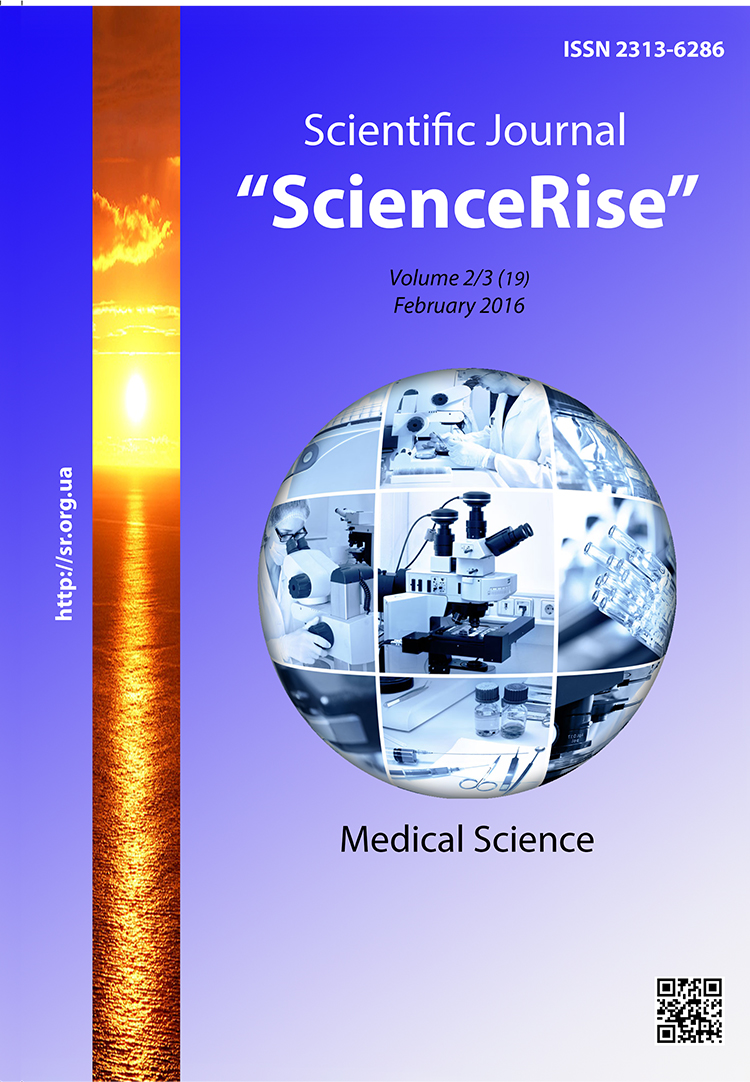Optimization of the diabetic nephropathy treatment with attention to the special features of cellular inflammation mechanisms
DOI:
https://doi.org/10.15587/2313-8416.2016.61111Keywords:
diabetic nephropathy, hypertonic disease, functional state of neutrophils, L-arginine hydrochlorideAbstract
Aim. Optimization of the diabetic nephropathy (DN) treatment in association with hypertonic disease (HD) based on the study of neutrophil chain of pathogenic cellular mechanisms of these diseases development and the special features of its clinical course.
Materials and methods. There were complexly examined 86 patients with HD associated with DN and 30 patients with isolated HD. The control group was formed by 30 practically healthy persons. The activity of NO-synthases in neutrophils was detected by Green colorimetric methods using Griess reagent. The expression of ІСАМ-1 (CD54), CD11b-integrin and inducible NO-synthase on neutrophils was detected by the indirect immunocytochemical method. Oxygen-depending activity of neutrophils was assessed in NBT-test.
Results. Expression of adhesive molecules of CD54and CD11b-integrin on neutrophils of peripheral blood essentially increases (р <0,001) in patients with DN in association with HD comparing with isolated HD and the control group.
At associated pathology on the background of high oxygen-depending activity of neutrophils its functional reserve decreases that results in intensification of inflammatory processes in kidneys (р<0,001).
In comorbid patients chronization of pathological process results in imbalance of NO-synthases system in neutrophils: on the background of decrease of activity of constituent NO-synthases the expression and activity of inducible NO-synthase increase (р<0,001) .
The use of L-arginine hydrochloride in the complex therapy of patients with DN associated with HD intensifies organoprotective effect of basal therapy, results in facilitation of the clinical course, decreases albuminuria, corrects the functional indices of neutrophils and diminishes imbalance in NO-synthases system.
Conclusions. In patients with DN in association with HD the neutrophil chain of cellular inflammation mechanisms are activated: expression of adhesive molecules grows, oxygen-depending metabolism is broken, expression and activity of cellular inducible NO-synthase are intensified.
Combined therapy with the use of L-arginine hydrochloride favors the decrease of tension of the studied systems of regulation and facilitation of the clinical course of disease
References
Gorbas', I. M. (2013). Epidemiologichna sytuacija shhodo sercevo-sudynnyh zahvorjuvan' v Ukrai'ni: 30-richne monitoruvannja. Ukrai'ns'kyj kardiologichnyj zhurnal, 6, 23–27.
Man'kovskij, B. N. (2014). Rasprostranennost' nevyjavlennogo saharnogo diabeta 2 tipa i prediabeta v Ukraine: rezul'taty jepidemiologicheskogo issledovanija «DIAPAZON». Diabet Ozhirenie Metabolicheskij sindrom, 5, 70–75.
Dedov, I. I., Shestakova, M. V. (2015). Algoritmy specializirovannoj medicinskoj pomoshhi bol'nym saharnym diabetom. Saharnyj diabet, 18 (1S), 11–17.
Noel Van Buren, P., Toto, R. (2013). Current Update in the Management of Diabetic Nephropathy. Current Diabetes Reviews, 9 (1), 62–77. doi: 10.2174/157339913804143207
Kratnov, A. E., Lopatnikova, E. N., Kratnov, A. A. (2012). Vnutrikletochnyj metabolizm nejtrofilov i risk razvitija saharnogo diabeta 2 tipa u bol'nyh s metabolicheskim sindromom. Saharnyj diabet, 2, 13–16.
Zarbock, A., Ley, K. (2008). Mechanisms and Consequences of Neutrophil Interaction with the Endothelium. The American Journal of Pathology, 172 (1), 1–7. doi: 10.2353/ajpath.2008.070502
Mogensen, C. E. (1982). Long-term antihypertensive treatment inhibiting progression of diabetic nephropathy. BMJ, 285 (6343), 685–688. doi: 10.1136/bmj.285.6343.685
Salter, M., Knowles, R. G., Moncada, S. (1991). Widespread tissue distribution, species distribution and changes in activity of Ca 2+ -dependent and Ca 2+ -independent nitric oxide synthases. FEBS Letters, 291 (1), 145–149. doi: 10.1016/0014-5793(91)81123-p
Men'shikov, V. V. (Ed.) (1987). Laboratornye metody issledovanija v klinike: Spravochnik. Moscow: Medicina, 368.
Lomakina, E. B., Waugh, R. E. (2009). Adhesion Between Human Neutrophils and Immobilized Endothelial Ligand Vascular Cell Adhesion Molecule 1: Divalent Ion Effects. Biophysical Journal, 96 (1), 276–284. doi: 10.1016/j.bpj.2008.10.001
Capellini, V. K., Celotto, A. C., Baldo, C. F., Olivon, V. C., Viaro, F., Rodrigues, A. J., Evora, P. R. B. (2010). Diabetes and Vascular Disease: Basic Concepts of Nitric Oxide Physiology, Endothelial Dysfunction, Oxidative Stress and Therapeutic Possibilities. Current Vascular Pharmacology, 8 (4), 526–544. doi: 10.2174/157016110791330834
Chatterjee, A., Catravas, J. D. (2008). Endothelial nitric oxide (NO) and its pathophysiologic regulation. Vascular Pharmacology, 49 (4-6), 134–140. doi: 10.1016/j.vph.2008.06.008
Das, U. N. (2011). L-arginine, NO and asymmetrical dimethylarginine in hypertension and type 2 diabetes. Frontiers in Bioscience, 16 (1), 13. doi: 10.2741/3672
Babushkina, A. V. (2009). L-arginin s tochki zrenija dokazatel'noj mediciny. Ukrains'kij medichnij chasopis, 6 (74), 45–49.
Nunes, S., Soares, E., Pereira, F. C., Reis, F. (2012). The role of inflammation in diabetic cardiomyopathy. International Journal of Interferon, Cytokine and Mediator Research, 4, 59–73. doi: 10.2147/ijicmr.s21679
Baylis, C. (2007). Nitric oxide deficiency in chronic kidney disease. AJP: Renal Physiology, 294 (1), F1–F9. doi: 10.1152/ajprenal.00424.2007
Haviarová, Z., Janegová, A., Janega, P., Durdík, Š., Kováč, P., Štvrtinová, V., Mráz, P. (2011). Expression of Constitutive Nitric Oxide Synthase Isoforms in Varicose Vein Wall; Preliminary Results. International Journal of Vascular Medicine, 2011, 1–6. doi: 10.1155/2011/204723
Mitsuke, Y., Lee, J.-D., Shimizu, H., Uzui, H., Iwasaki, H., Ueda, T. (2001). Nitric oxide synthase activity in peripheral polymorphonuclear leukocytes in patients with chronic congestive heart failure. The American Journal of Cardiology, 87 (2), 183–187. doi: 10.1016/s0002-9149(00)01313-8
Downloads
Published
Issue
Section
License
Copyright (c) 2016 Тетяна Дмитрівна Щербань

This work is licensed under a Creative Commons Attribution 4.0 International License.
Our journal abides by the Creative Commons CC BY copyright rights and permissions for open access journals.
Authors, who are published in this journal, agree to the following conditions:
1. The authors reserve the right to authorship of the work and pass the first publication right of this work to the journal under the terms of a Creative Commons CC BY, which allows others to freely distribute the published research with the obligatory reference to the authors of the original work and the first publication of the work in this journal.
2. The authors have the right to conclude separate supplement agreements that relate to non-exclusive work distribution in the form in which it has been published by the journal (for example, to upload the work to the online storage of the journal or publish it as part of a monograph), provided that the reference to the first publication of the work in this journal is included.

